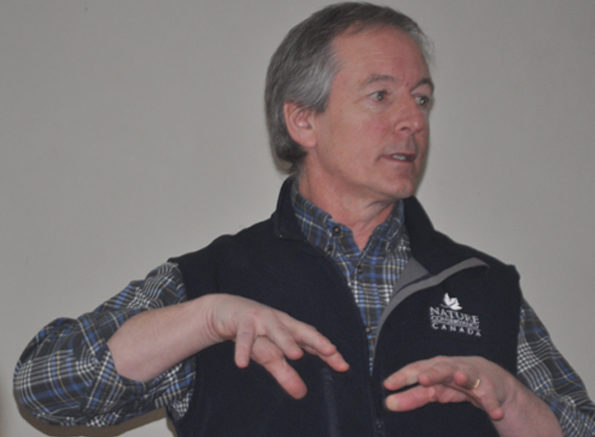Adam Bramburger
Beaver Staff
The Nature Conservancy of Canada (NCC) is continuing is preservation work on the Napanee Plain and it is poised to add another significant parcel of land near Camden East.
On Saturday, the NCC’s central Ontario-east program director Mark Stabb visited the Friends of the Napanee River Watershed in Newburgh to talk about the plain’s geology and habitat.
“One of the things that actually is really neat about the Napanee Plain is it’s not a spectacular landscape, unless you know how to look at it,” Stabb said.
While many might look at properties in this region as scrub land with their limited vegetation and shallow soil, Stabb indicated the NCC and other naturalists are quite interested in the habitats hosted by the 439,848-acre plain, including fen — wetlands located over limestone, and alvar — flat limestone bedrock with shallow soil and sparse vegetation. Stabb said the landscape is kept open by flooding in the spring, heavy drought in the summer, and severe frost in the winter.
Stabb called Napanee’s limestone plain “the home of alvar in Canada,” noting the term alvar wasn’t even being used locally until visitors from Scandinavia visited Queen’s botanist Adele Crowder near Camden East and shared the description with her. He noted the landform was likely created following glaciation and spreading across the Great Lakes basin, which is why similar limestone formations can be seen in areas like the Bruce Peninsula and near Green Bay, WI.
“Another way to look at it is it’s like a natural rock garden,” Stabb said. “There are very few things that really survive and survive well here.”
Plants drive the ecosystem and some are exceptionally rare globally, including the juniper sedge. There are species of insect that are linked directly to altars and its open nature is important for grassland birds. In particular, Stabb spoke about the endangered eastern loggerhead shrike.
“The shrikes are here because landowners are really taking care of the habitat and the alvars are naturally open. That combination has meant this is one of the hotbeds and last refuges for shrike in Ontario. The combination of landlord stewardship and natural openness has really helped.”
The NCC became more actively involved with shrike habitat after biologist Chris Grooms found a shrike nest off County Rd. 27 north of Newburgh. He encouraged the organization to buy land and engage in habitat restoration. Stabb said it marked the first time the NCC specifically bought property because of a species. Starting with one property, bought from the Scheck family, the NCC has continued to buy land and now it has an over 300-acre parcel of grassland alvar for shrike habitat.
“Since then, we’ve been active managers of that property,” he said, adding volunteers have made large brush piles to stop the spread of red cedar and to allow shrike to have something to impale prey on. They’ve also put up wires away from the road to provide a safe perching area and expanded the size of the preserve because “grasslands birds do better in larger open grasslands than small grasslands.”
Stabb said an ongoing challenge in alvar is finding ways to allow cattle to graze and not disrupt the biodiversity of wildflowers that grow in the area.
During his presentation, Stabb indicated the NCC has helped to create a nature preserve where people can visit to see undisturbed fen habitat. It also features the Salmon River Alvar. That’s the Menzel Centennial Provincial Nature Reserve at the north end of Deseronto Road. It was set aside in 1997 after Deiter Menzel donated the land in memory of his late wife Oivi, whom he said made him a nature lover.
“It was sort of our first crack and working and making a conservation contribution to this landscape,” Stabb said. “It’s a nice pristine place.”
Soon, Stabb said, it is hoped the NCC will have a spot on the Camden East Alvar, a provincially designated area of natural and scientific interest, to protect and to allow people to experience an undisturbed plot of nature. Working with the Lennox and Addington County Stewardship Council, the NCC made presentations to Loyalist Township to see a 100-acre parcel of land, known as the Camden East dump, donated as a conservation area. Councillors supported the plan in principle last Monday.
Stabb said upon the transfer the NCC will study what species are there, what may be in danger or threatened, and where public access would least disturb the ecosystems.
“There’s a really exciting opportunity there,” he said.
Meanwhile, the NCC has also announced it will open an office at the Napanee Business Centre to house staff who will manage its properties in the area. Biologist Amanda Tracey has been hired to continue that work.

